I decided to use my new photography tool, a DJI Inspire 1 quadcopter, to take some beam shots in a large photo shoot. I gathered 19 flashlights in all that I thought would be great for comparison as well as being some of my brightest lights. Included are lights ranging from a few oldie but goodies, some current power houses, and even a new prototype model. Here is the list of lights used in this shoot in order of appearance.
Sunwayman D40A
ThruNite TN4A
Fenix TK35UE
ThruNite TN30
ThruNite TN30 Mini
Fandyfire Warrior JM
Fenix LD60
Manker Godmes
Solarstorm SP03
Powertac X3000
ThruNite TN32
ThruNite TN35
Acebeam K40M
Fenix TK61
Imalent DDT40
Black Shadow Terminator JM
Niwalker MM15
ThruNite TN36
Trustfire TR-S700
So, let’s get started! Below is all the hardware gathered and waiting to be loaded into the car for the trip to the airfield.
Here are the majority of the cells ready for installation. It took a few hours, 4 chargers, and constant swapping to get them all topped off.

OK! Finally at the airfield! After unloading all the lights and getting them lined up in shooting order on a picnic table so I can keep track of which light is in each photo, I prepped the quad for flight and set up for the shoot at the preplanned spot.
Below is a picture of the location as well of the light path of 360m I’d chosen ahead of time.
The air was still very humid from the previous 3 or 4 horribly muggy days. This humidity cut down on the beam penetration and the lights did show better in person than in the photos but are pretty close to being there. At the very least all shots are on the same settings and still great for comparing against each other. There was some wind as the night air cooled off which caused a few of the photos to be slightly blurry. I have to say I’m pretty impressed by my Inspire 1 for how steady it is in the air. Super stable as it hung 10 meters above and behind me. Most of the pics are clean enough to make one think the camera was on a tripod on a rooftop. 😀
The first light up is an SWM D40A running XM-L2 emitter driven by four Duraloop cells.
Next up is the ThruNite TN4A NW. It also runs a single XM-L2 with four Duraloop cells. Where the SWM D40A used to be king of the 4xAA lights, the TN4A has staged a hostile take over, stolen the throne, and decapitated the old king. Long live King TN4A!
Next up is the Fenix TN35 Ultimate Edition. This light runs what appears to be a 5k tint MT-G2 powered by two 18650 cells. All flood and smooth beam With 1700-1800 OTF lumens it’s a great, compact light but with disappointing output with it’s under-driven MT-G2 emitter.
Next up is the ThruNite TN30. This light as super deep, large for it’s head size, reflectors that allow the 3*XM-L2 emitters to kick lots of flood combined with really good throw for a fairly small headed triple. You can see in the pic that it does indeed hit the trees 360m away and pretty well, too. This light is an oldie but goodie!
Next up is the successor to the TN30. It’s the TN30 Mini which also runs 3*XM-L2 emitters powered by four 18650 cells in a very short, fat host. The reflectors on this pocket monster are orange peeled and pretty shallow but combined they produce a very smooth spill, especially compared to the older TN30. In spite of the shallow reflectors it still manages to hit the trees 360m away, just not as well as the larger, deeper reflectored TN30. The new Mini is indeed a force to be reckoned with and one every flashaholic should put on his/her short list.
Next up is my modified FF Warrior. This light runs on 3*XM-L emitters powered by three 18650 cells. It’s been resistor modded for greater output. Even with the mods it only equals the stock TN30 Mini in throw without the bright, smooth spill of the Mini. It’s still a good budget light consideration if you are on a tight budget.
Next up is the Fenix LD60. This is a triple XM-L2 light powered by three 18650 cells. It’s larger, deeper reflector cups produce marginally farther throw than the compact TN30 Mini but without any of the spill. How do I feel about this light? Meh. It’s wholly unremarkable and over priced for it’s horrible flicker, cheap-ass holster, and average performance.
Next up is my prototype version of the all new Manker Godmes. This flashlight has incredible performance for a triple XM-L2 light with individual reflectors similar in design to the Eye30. The throw blew me away and really surprised me. Very little beam overlap “bloom” in the edges of the smooth spill the the very focused beam is quite remarkable considering the small, compact host. What makes this light different from any other on the market is that its UI can be completely customized by the flashlight owner via Bluetooth wireless using a smart phone or tablet. Build quality is exceptional and the performance is VERY good for it’s claimed 3000 lumens!
Next up (below) is another oldie but goodie budget entry: The Solarstorm SP03. This huge headed triple XM-L light is run by four 18650 cells. Only about 2300 lumens stock, it throws very well thanks to it’s huge reflector. Think of it as the poor man’s TK75.
The next light below is the Powertac X3000. This unique triple XM-L2
light also packs 3 XP-E emitters, (one each red, blue, green) for white, red, blue, or green output. Strobes in any color as well as a bright police strobe. It’s a very pricey light but is made for professionals and is built like a brick shit house. Performance is very good as you can see by the pic below. It throws much farther than you’d have thought it would and can be seen lighting the tree line 360m away.
Next up is the mighty ThruNite TN32 thrower. This XM-L2 thrower has a gorgeous, large reflector and is powered by three 18650 cells. With 172kcd stock, it’s a hell of a thrower. Dedoming the emitter will bump the throw to close to 400kcd. It’s still arguably one of the best stock throwers you can buy.
Next up is the ThruNite TN35. The same body, head, and reflector as the TN32 (above) but with a gorgeous MT-G2 emitter instead of the XM-L2. What does this get you? The output of a triple XM-L2 but with a nice, smooth beam and almost as much throw as the TN32. One look at the gorgeous beam and you’ll understand why it’s a favorite light for many flashaholics.
Similar to the TN35, the Acebeam K40M is a big MT-G2 light powered by three 18650 cells. Nearly the same body and UI as the TN35 but with a slightly smaller head, the K40M is a steal of a light and an incredible performer with wider spill and even better throw than the TN35. You can’t go wrong having an Acebeam K40M in your light arsenal.
Next is the Fenix TK61 thrower. This single XM-L2 thrower has only 1000 lumens but equals the TN32 in throw by virtue of it’s enormous head and well designed reflector. It’s not a very bright light but it sure does reach out and touch with it’s highly focused beam and very little spill.
The Imalent DDT40 is Imalent’s newest monster light. The quad XM-L2 light pumps out an honest 3600 OTF lumens with a great beam profile and throw.
In addition to the four XM-L2 emitters in the front of the light, the DDT40 has an XP-G2 NW emitter in either side of the head making it capable of lighting up a large area with smooth white flood.
Next up is my baby. Born from one of my favorite lights, the Black Shadow Terminator, this “JM” edition has been modified by me with a BLF SRK FET driver feeding current to four dedomed XM-L2 1A emitters. With around 3800 OTF lumens, this compact killer packs a bright, wide beam with throw nearly rivaling that of the best dedicated throwers. The UI allows me to scroll up or down through 7 output levels and gives me instant access to either full Turbo or Moon Low. The gorgeous NW tint from the dedomed emitters is the icing on the cake.
Ahh…the Niwalker MM15 dual MT-G2 compact powerhouse. It’s a great little light with it’s 5000+ lumen output and tons of spill. I thought it was fantastic until I got…
The TN36 NW compact monster! This little light with it’s triple MK-R emitters makes the MM15 it’s bitch in every aspect. More lumens, smoother spill, farther throw, better tint. This light is a keeper and should be owned by all flashaholics!
Last up in our beam show is the Trustfire TR-S700. This humongous beast of a light has 7 XM-L emitters driven by three 26650 cells. The host is a hoss and a half. It’s magnetic switch provides fully variable output. I suppose with the knowledge of how to integrate the magnetic switch into an updated driver, this light could be made into one hell of a hotrod. As a stock light it performs well but is equaled or bettered by the current crop of XM-L2 triples.
Well, that’s all for the show. I hope you enjoyed this batch of beam shots and that it helped show the differences in many of today’s popular lights. I plan on using more aerial photos in the future. Anything you want to see just let me know and if I have it I will include it in a future beam shot session.
Cheers!
Johnny

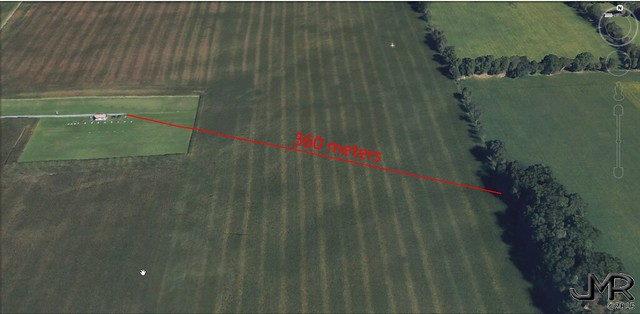
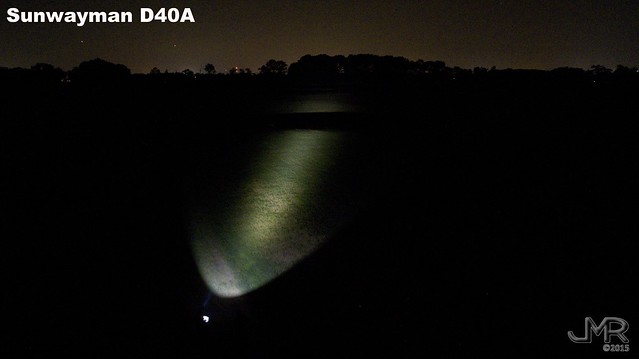
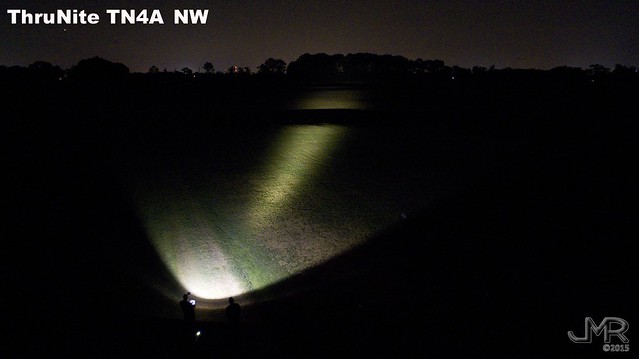
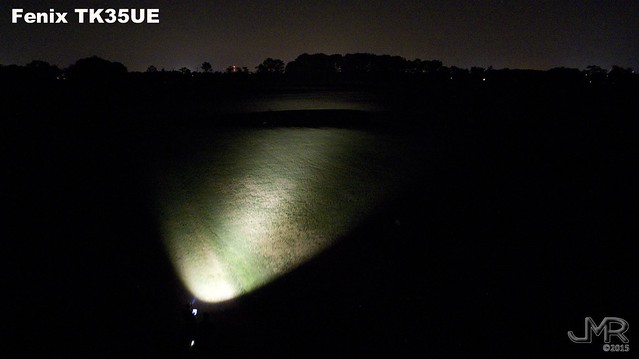
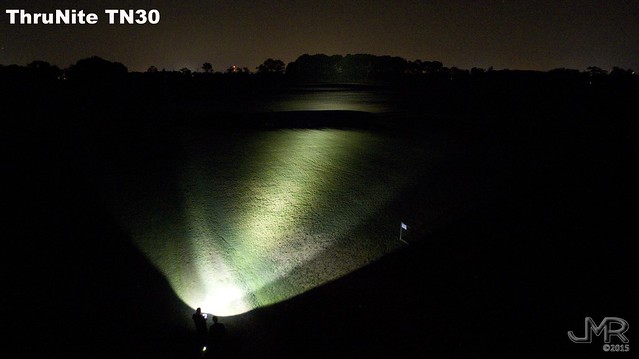
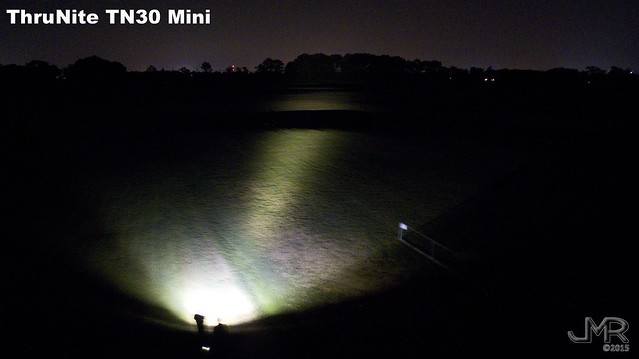
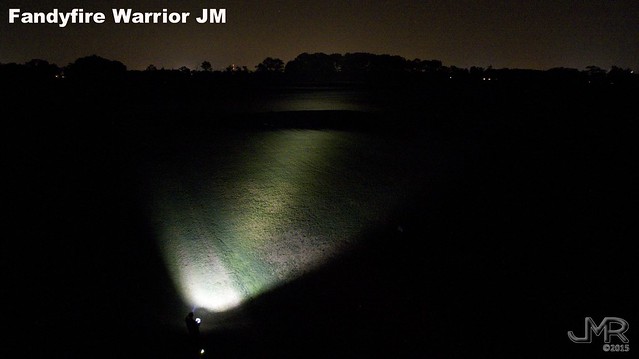
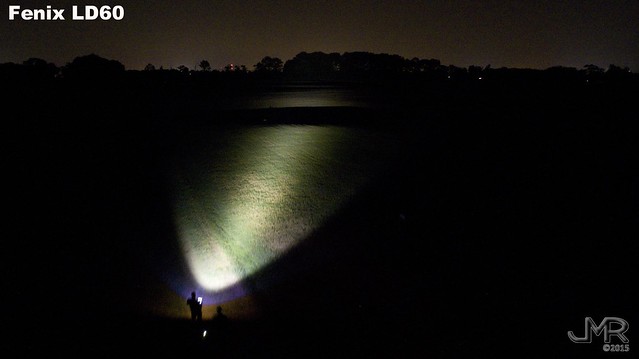
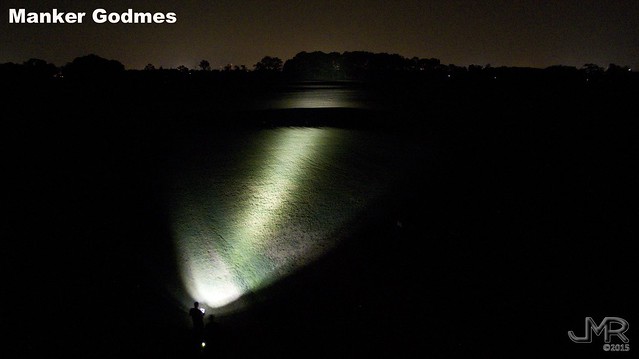
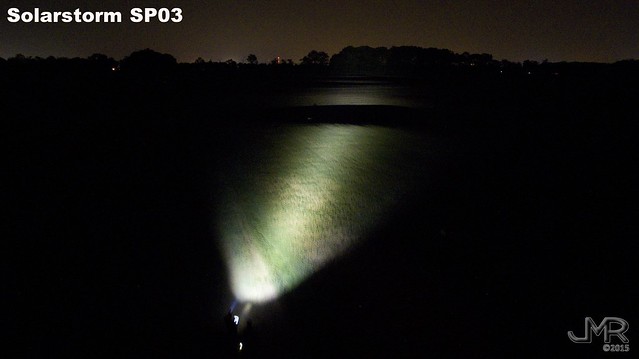


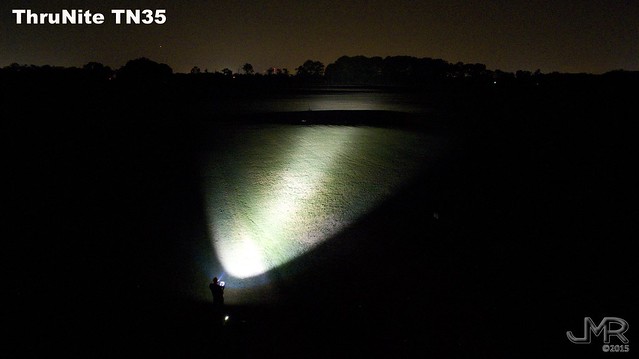
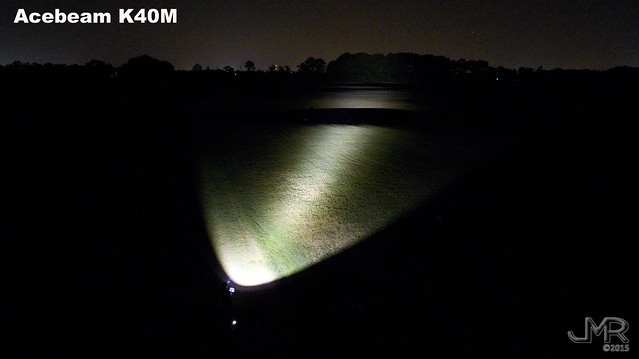

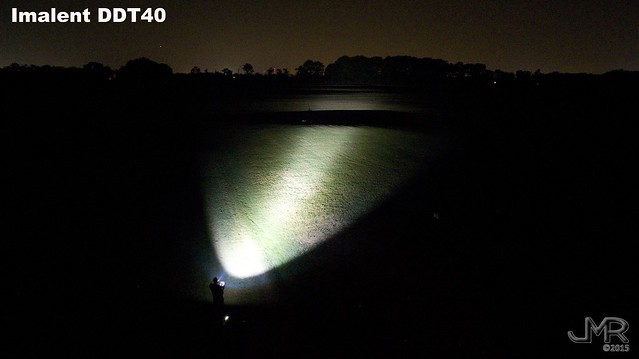

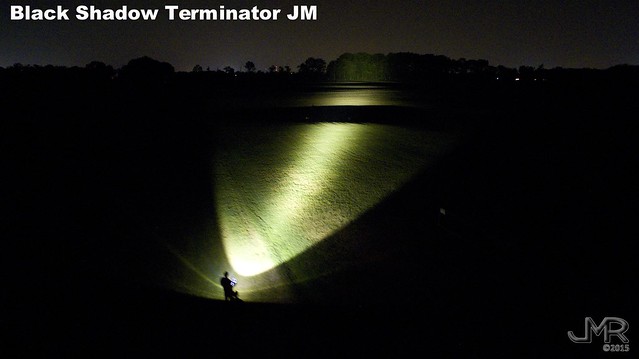
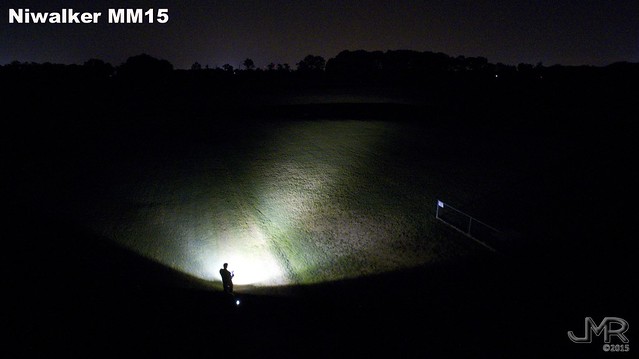

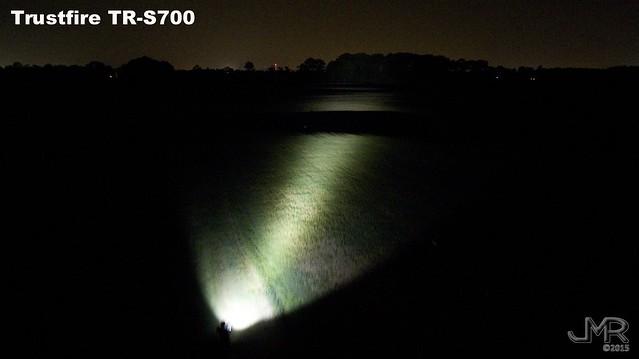
Pingback: 19 Flashlight Aerial Beam Shot Showdown! | Johnny Mac Reviews
What is the purpose of a dome and how does one remove it?
So sorry for the late reply. I completely missed your comment until now. Because Cree (and other LED manufacturers) make their LEDs for commercial lightingand residential lighting next with flashlight use not so much if at all, the purpose of the dome is to focus most of the light from the LED like a lens and ensure the majority of light shines forward instead of everywhere. It puts the light where you need it.
In a flashlight, light is thrown forward, especially in one designed for maximum throw, by the light from the LED reflecting off of the parabolic curve of the reflector. In a domed LED more of the light emitted shines forward instead of to the sides. This means that a large amount of the light is not being reflected off of the reflector.
By dedoming the LED, the light from the LED surface shines more or less equally in a 180 degree hemi-sphere. This allows more light to shine to the sides where the reflector can focus them for maximum range. There are many methods to dedome an LED but the easiest and most reliable way to dedome it without damaging the bond wires that feed current to the substrate is this: Take a small mason jar or babyfood jar and fill it 2/3 full with high test gasoline. Drop your MCPCB (the copper or aluminum disk the LED is mounted to) with LED attached into the gasoline. Let it sit anywhere from a few hours to overnight. The dome will simply fall off leaving the LED and phosphor coating in perfect condition. If there are any little bits stuck on the outer edges just grab a magnifying glass and a toothpick and carefully push off any remnants of the dome. Just be very careful not to touch the tiny gold bond wires on the LED. Break them and it won’t work.
Rinse the MCPCB and dedomed LED off in rubbing alcohol and let dry. Once dry, reinstall the MCPCB into the flashlight and resolder the power leads to the contact pads. Your LED is now dedomed perfectly and you will see, on average DOUBLE the throw candela you had before the dedoming! If you have a light with a rating of 125,000cd, after dedoming you would likely see 250,000cd. It can turn a good mid-range torch into a thrower, and a good thrower into a monster thrower.
Great shots , really impressed . I just wish all the lights were represented stock configureation . I have several modified lights and some are impractical to use in turbo mode due to heating. life is good!
your custom lite is unreal! damn….